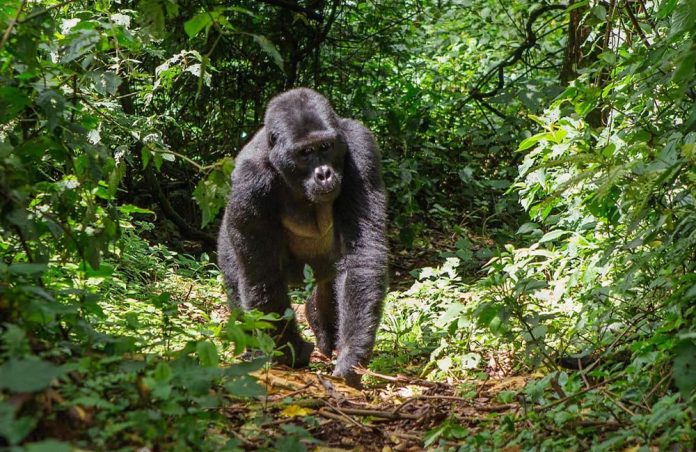Whatever you call it either gorilla trekking or tracking, it’s one of those really thrilling, lifetime experiences you should take time for before you leave planet earth.
Gorillas in Uganda are tracked in Bwindi Impenetrable National Park and Mgahinga Gorilla National Park. Bwindi impenetrable national park has ten habituated families thus it can host 80 persons tracking gorillas per day since 8 persons are allowed to visit a given gorilla family per day while gorilla tracking in Rwanda is carried out only in volcanoes national park whose gorillas are the mostly wholly habituated and often found in bamboo than the dense forest which makes photographing easier.
1. Ease of Securing Gorilla Permits
Gorilla permits in Rwanda are more pricier compared to those of Uganda. In Rwanda, gorilla permits go to the tune of US1500 per permit compared to Uganda’s US$700 per permit. However Rwanda’s edge over others lies in the ability for one to go and track within one day and then fly back home on the same day since it’s a 2 hours drive from Kigali to volcanoes national park unlike Uganda’s Bwindi impenetrable national park which lies a whooping 8 hours drive form Kampala which makes a one day tracking totally impossible.
2. Accessibility to Gorilla Parks
Rwanda’s roads linking to volcanoes national park are generally in better conditions if compared to Uganda’s roads heading to Bwindi impenetrable national park. The distance between Kigali and Volcanoes National Park is also shorter! That is why a gorilla safari in Rwanda can be a day trip or 2 Days which is not the case with uganda where the shortest trip is a 3 Days Safari. However, the long drive to Bwindi impenetrable national park is endowed with great sceneries all through like the Equator, lake Mburo national park, abundant wildlife, terraced mountains with flowing rivers things that not exist on the Kigali drive to the volcanoes.
The longer distance to and from Bwindi Forest Park and the international airport in Entebbe (just outside Kampala) add to your travelling costs on the Uganda side. The drive is further in Uganda, but it is scenic and offers insight into rural Africa. A gorilla trekking safari in Uganda can as well include spending time at beautiful Lake Bunyonyi close to Bwindi and game viewing in Queen Elizabeth National Park through the Ishasha sector while the short drive in Rwanda is on the other hand not particularly scenic or interesting.
3. More Incentives
Hospitality wise, Rwanda ranks a head of Uganda on the gorilla tracking day. This is manifested in the staff conduct towards the visitors. At exactly 7:00 am, tea/coffee dispensers with cups are laid for the visitors going for the trek. One is free to take as much as he/she wishes and during that time, they are entertained by the lively traditional dance troupe [SACOLA Traditional Dancers] that portrays Rwanda’s rich culture while in Uganda, this tea is not served and the dance you enjoy it at an extra cost.
4. Where to Stay
In terms of accommodation, both countries boast of great places to stay. Rwanda’s Sabinyo silverback lodge, mountain gorilla view lodge, gorilla nest camp are really very enticing to visitors. However, Uganda’s accommodation stands out of the crowd. Some of the best lodges include; Silverback Lodge, Gorilla Safari Lodge, Gift of Nature Lodge, Jungle View Lodge, Volcanoes Safaris Bwindi Lodge.
5. Gorilla Treks
In Uganda the gorillas tend to be found deeper in the forest in groups of between 10 and 20, with at least one silverback. In Rwanda groups range between 9 and 39 gorillas including at least one silverback. The trekking itself is generally more challenging in Bwindi (Uganda) given that the gorillas are more tucked away and after viewing the gorillas you often have to ascend steep slopes out of the forests. In Rwanda some of the gorilla groups are often found closer to the park entrance, requiring a shorter hike. You can’t however request which gorilla groups you want to see and the location of the groups does shift further into the forests.
6. Safety and Security
Rwanda and Uganda are politically stable at this moment. Rwanda recovered from the genocide that took place in the early 1990’s whereby the Volcanoes National Park can be visited safely, is well managed and has a permit system that is functioning efficiently. Uganda has also been very safe since their political war that ended in 1986.Bwindi forest is very safe and they also have an efficiently functioning permit system. However, In the DRC civil war and conflicts are a problem, and conditions need to be checked before you travel. Militia groups and the army are currently fighting in the Virunga area, where poachers threaten the gorilla populations and poverty is leading to habitat destruction. Some travel advisory organizations consider the area too volatile for travel and recommend avoiding the DRC at present.






